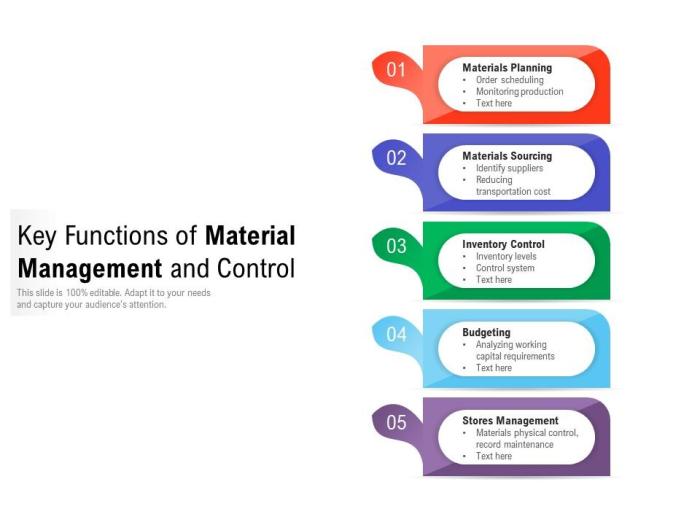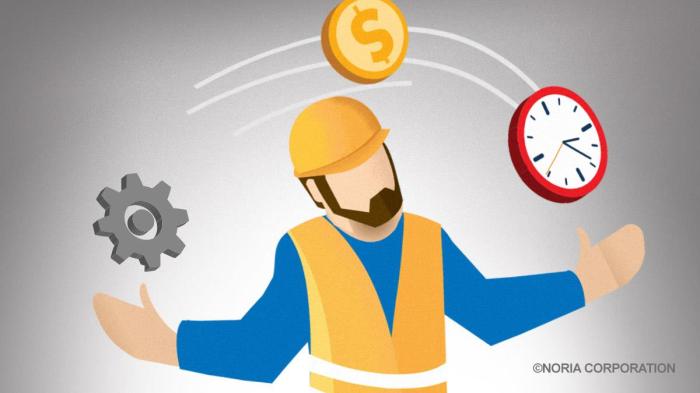The promulgation of the maintenance and material management – The promulgation of maintenance and material management is a crucial aspect of any organization seeking to optimize its operations and ensure the longevity of its assets. This guide delves into the intricacies of promulgating effective maintenance and material management policies and procedures, providing a comprehensive understanding of their purpose, significance, and implementation.
By establishing clear guidelines and standards, organizations can streamline their maintenance and material management processes, enhance efficiency, and minimize disruptions. This guide explores the key elements of a successful maintenance and material management system, including the interrelationships between these elements and best practices for managing each one.
1. Promulgation of Maintenance and Material Management
Promulgation in the context of maintenance and material management refers to the process of communicating and implementing policies, procedures, and guidelines to ensure effective management of maintenance and material resources. It involves establishing clear expectations, responsibilities, and practices for all stakeholders involved in these functions.
The purpose of promulgating maintenance and material management policies and procedures is to:
- Ensure consistency and uniformity in maintenance and material management practices
- Establish clear lines of authority and responsibility
- Provide guidance on best practices and industry standards
- Facilitate efficient communication and coordination
- Improve compliance with regulatory and safety requirements
Effective promulgation methods for maintenance and material management include:
- Issuing written policies and procedures
- Conducting training and awareness sessions
- Using online platforms and databases
- Regularly reviewing and updating policies and procedures
2. Elements of Maintenance and Material Management

An effective maintenance and material management system consists of several key elements that work together to ensure efficient operations. These elements include:
- Preventive Maintenance:Regular maintenance tasks performed to prevent equipment failures and breakdowns.
- Predictive Maintenance:Monitoring equipment condition to predict potential failures and schedule maintenance accordingly.
- Corrective Maintenance:Repairing or replacing equipment after a failure or breakdown.
- Material Planning and Control:Managing inventory levels, ordering materials, and ensuring availability.
- Quality Control:Ensuring that maintenance and material management processes meet quality standards.
- Performance Measurement:Tracking key metrics to evaluate the effectiveness of maintenance and material management.
These elements are interrelated and contribute to overall efficiency by:
- Reducing equipment downtime and improving reliability
- Optimizing inventory levels and minimizing waste
- Improving communication and coordination between maintenance and material management teams
- Ensuring compliance with safety and regulatory requirements
3. Maintenance and Material Management Policies and Procedures: The Promulgation Of The Maintenance And Material Management

Clear and comprehensive policies and procedures are essential for effective maintenance and material management. These policies and procedures should:
- Define roles and responsibilities
- Establish maintenance and material management processes
- Set performance standards and metrics
- Provide guidance on safety and regulatory compliance
- Ensure consistency and uniformity in practices
The steps involved in developing and implementing effective policies and procedures include:
- Identify the need for policies and procedures
- Develop draft policies and procedures
- Review and revise draft policies and procedures
- Communicate and implement policies and procedures
- Monitor and evaluate policies and procedures
| Maintenance Policy | Maintenance Procedure | Material Management Policy | Material Management Procedure |
|---|---|---|---|
| Preventive Maintenance Policy | Preventive Maintenance Procedure | Material Planning and Control Policy | Material Ordering Procedure |
| Predictive Maintenance Policy | Predictive Maintenance Procedure | Inventory Management Policy | Inventory Control Procedure |
| Corrective Maintenance Policy | Corrective Maintenance Procedure | Quality Control Policy | Quality Control Procedure |
| Performance Measurement Policy | Performance Measurement Procedure | Safety and Regulatory Compliance Policy | Safety and Regulatory Compliance Procedure |
4. Maintenance and Material Management Metrics

Key metrics used to measure the effectiveness of maintenance and material management systems include:
- Equipment Availability:The percentage of time that equipment is available for use.
- Equipment Reliability:The probability that equipment will perform its intended function without failure.
- Maintenance Costs:The total cost of maintenance activities.
- Inventory Turnover:The number of times inventory is used and replaced in a given period.
- Customer Satisfaction:The level of satisfaction of customers with maintenance and material management services.
Tracking and analyzing these metrics is important for:
- Identifying areas for improvement
- Setting performance targets
- Evaluating the effectiveness of maintenance and material management strategies
- Making data-driven decisions
5. Maintenance and Material Management Technologies

Technology plays a vital role in improving maintenance and material management. Specific technologies used include:
- Computerized Maintenance Management Systems (CMMS):Software used to manage maintenance activities and track equipment performance.
- Predictive Maintenance Software:Software that monitors equipment condition and predicts potential failures.
- Inventory Management Systems:Software used to manage inventory levels and track material usage.
- Radio Frequency Identification (RFID):Technology used to track the location and usage of materials.
- Automated Material Handling Systems:Systems used to automate the movement and storage of materials.
Benefits of implementing maintenance and material management technologies include:
- Improved equipment reliability and availability
- Reduced maintenance costs
- Optimized inventory levels
- Enhanced communication and coordination
- Increased efficiency and productivity
Challenges of implementing maintenance and material management technologies include:
- High initial investment costs
- Need for training and support
- Integration with existing systems
- Data security concerns
6. Maintenance and Material Management Case Studies
Organizations that have successfully implemented effective maintenance and material management systems include:
- Toyota:Implemented a Total Productive Maintenance (TPM) system that significantly improved equipment reliability and reduced maintenance costs.
- GE Aviation:Used predictive maintenance technology to reduce unplanned downtime by 50%.
- Amazon:Implemented an automated inventory management system that optimized inventory levels and reduced storage costs.
These case studies demonstrate the benefits of implementing effective maintenance and material management systems, including improved equipment reliability, reduced costs, and enhanced efficiency.
Questions Often Asked
What is the purpose of promulgating maintenance and material management policies and procedures?
Promulgating maintenance and material management policies and procedures establishes clear guidelines and standards for employees to follow, ensuring consistency, efficiency, and compliance.
What are some effective methods for promulgating maintenance and material management policies and procedures?
Effective promulgation methods include issuing written policies and procedures, conducting training sessions, and providing regular updates and reminders to employees.
What are the key metrics used to measure the effectiveness of maintenance and material management systems?
Key metrics include mean time to repair, mean time between failures, inventory turnover ratio, and overall equipment effectiveness.